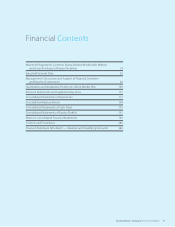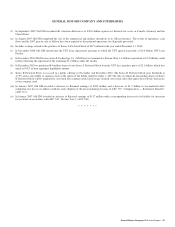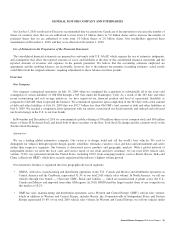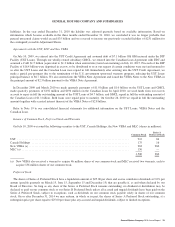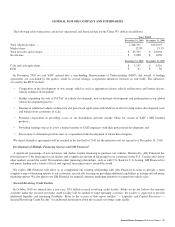General Motors 2010 Annual Report Download - page 30
Download and view the complete annual report
Please find page 30 of the 2010 General Motors annual report below. You can navigate through the pages in the report by either clicking on the pages listed below, or by using the keyword search tool below to find specific information within the annual report.GENERAL MOTORS COMPANY AND SUBSIDIARIES
strengthen our GMSA product portfolio through three strategies: (1) leveraging our global architectures; (2) pursuing local and
regional solutions to meet specific market requirements; and (3) expanding our joint venture partner collaboration
opportunities.
•Ensure competitive financing is available to our dealers and customers. We currently maintain multiple financing programs
and arrangements with third parties for our wholesale and retail customers to utilize when purchasing or leasing our vehicles.
Through our long-standing arrangements with Ally Financial and a variety of other worldwide, regional and local lenders, we
provide our customers and dealers with access to financing alternatives. We plan to further expand the range of financing
options available to our customers and dealers to help grow our vehicle sales through two specific objectives: (1) ensure
certainty of availability of financing; and (2) competitive and transparent pricing for financing, for our dealers and customers.
We expect GM Financial will offer increased availability of leasing and sub-prime financing for our customers in the United
States and Canada throughout economic cycles. We also plan to use GM Financial to initiate targeted customer marketing
initiatives to expand our vehicle sales.
Reduce breakeven levels through improved revenue realization and a competitive cost structure. In developed markets, we are
improving our cost structure to become profitable at lower industry volumes.
•Capitalize on cost structure improvement and maintain reduced incentive levels in GMNA. We plan to sustain the cost
reduction and operating flexibility progress we have made as a result of our North American restructuring. Our current U.S.
and Canadian hourly labor agreements provide the flexibility to utilize a lower tiered wage and benefit structure for new hires,
part-time employees and temporary employees. We aim to increase our vehicle profitability by maintaining competitive
incentive levels with our strengthened product portfolio and by actively managing our production levels through monitoring of
our dealer inventory levels. For the twelve months ended December 31, 2010 and based on GMNA’s 2010 market share,
GMNA’s earnings before interest and taxes (EBIT) (EBIT is not an operating measure under U.S. GAAP — refer to
“Reconciliation of Consolidated, Automotive and GM Financial Segment Results” for additional discussion) would have
achieved breakeven at GMNA wholesale volume of approximately 2.3 million vehicles, consistent with an annual U.S.
industry sales volume of approximately 9.5 to 10.0 million vehicles.
•Execute on our Opel/Vauxhall restructuring plan. We expect our Opel/Vauxhall restructuring plan to lower our vehicle
manufacturing costs. The plan includes manufacturing rationalization, headcount reduction, labor cost concessions from the
remaining workforce and selling, general and administrative efficiency initiatives. Specifically, we have reached an agreement
to reduce our European manufacturing capacity by 20% through, among other things, the closing of our Antwerp facility in
Belgium and the rationalization of our powertrain operations in our Bochum and Kaiserslautern facilities in Germany.
Additionally, we have reached an agreement with the labor unions in Europe to reduce labor costs by Euro 265 million per
year. The objective of our restructuring, along with the refreshed product portfolio pipeline, is to restore the profitability of the
GME business.
•Enhance manufacturing flexibility. We primarily produce vehicles in locations where we sell them and we have significant
manufacturing capacity in medium- and low-cost countries. We intend to maximize capacity utilization across our production
footprint to meet demand without requiring significant additional capital investment. For example, we were able to leverage
the benefit of a global architecture and start initial production for the U.S. of the Buick Regal 11 months ahead of schedule by
temporarily shifting production from North America to Rüsselsheim, Germany.
Maintain a strong balance sheet. Given our business’s high operating leverage and the cyclical nature of our industry, we intend to
minimize our financial leverage. We plan to use excess cash to repay debt and to make discretionary contributions to our U.S. pension
plans. Based on this planned reduction in financial leverage and the anticipated benefits resulting from our operating strategy
described above, we will aim to attain an investment grade credit rating over the long-term.
28 General Motors Company 2010 Annual Report



